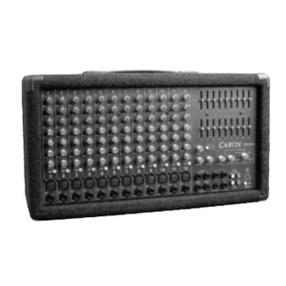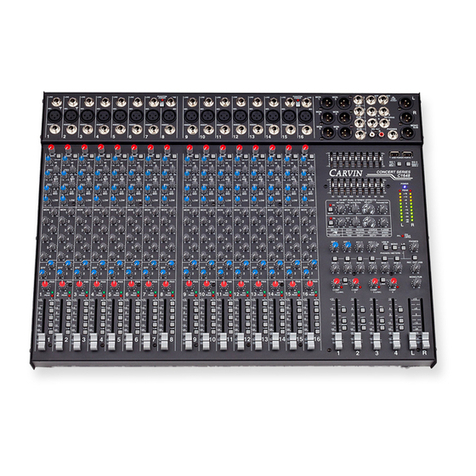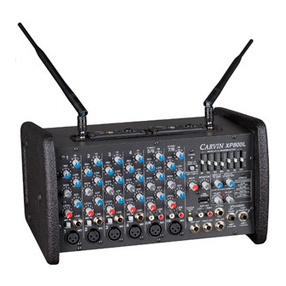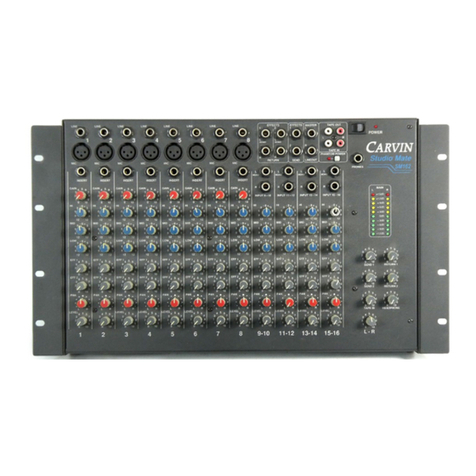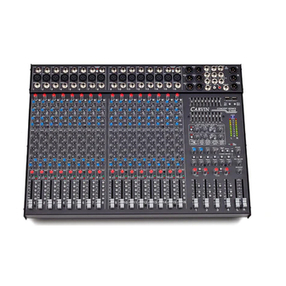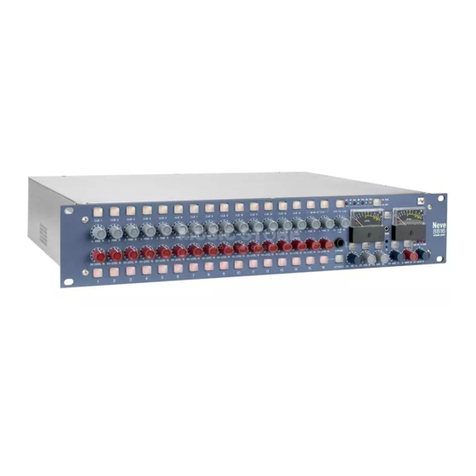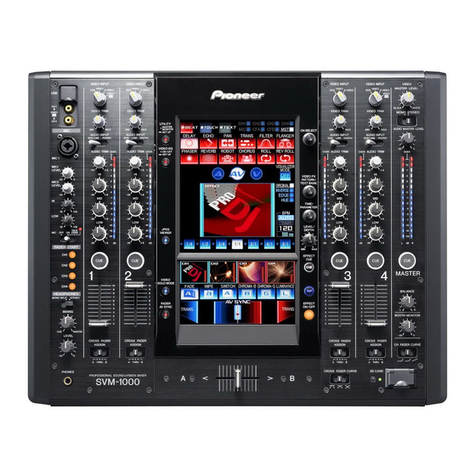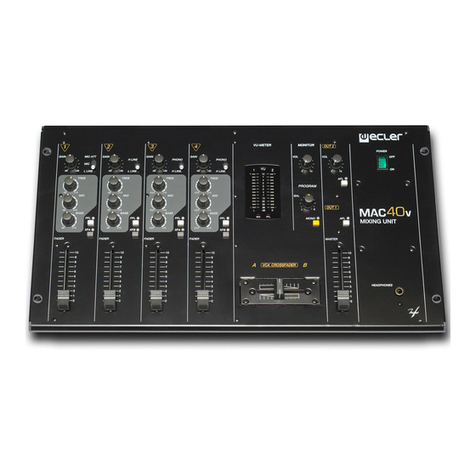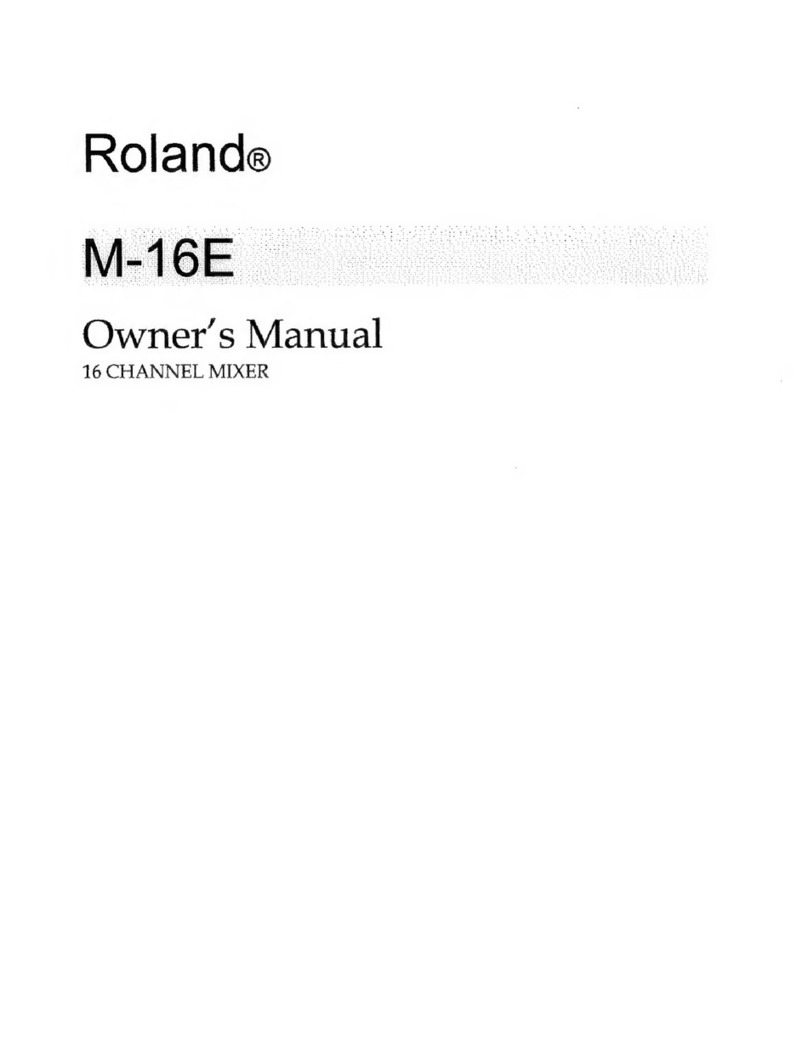
10
C SERIES CONTROLS
CHANNEL FEATURES
1. 1/4” LINE INPUTS
The line connectors are for connecting balanced and unbal-
anced instruments and line level sources such as drum
machines, keyboards, ETC.
2. XLR MIC INPUTS
The balanced Mic inputs are for connecting microphones that
use XLR connections. Both the LINE and XLR MIC inputs
can be used simultaneously.
3. CHANNEL INSERT/DIRECT OUT
To insert channel effects, compressor, etc. use a 1/4” TRS (Tip
Ring Sleeve) cable (see INSERTS AND DIRECT OUT illustration
on page 13). To achieve a direct out from the channel, insert a
standard 1/4” cable to the first “click” (1/2 insert).
4. GAIN
The GAIN controls the input level for the channel. If the GAIN
is set too high, the PEAK LED will flash and distortion may
occur. Decrease the amount of GAIN until the PEAK LED
does not flash. It is important that the gain control should be
kept next to the PEAK LED flash point to maintain the lowest
noise of the channel. You can use the channel PFL switch to
monitor the channel input level and use the meters to adjust
the GAIN control to 0dB. This will give a good reference where
the GAIN control should be set.
5. LOW CUT SWITCH
A 75 Hz LOW CUT filter helps eliminate unwanted low frequen-
cies. Great for reducing “boom” noise from mic stands or
from acoustic/electric guitars. Turning up the LOW EQ when
using this filter can help create a punchier bass response.
6. 4 BAND ACTIVE EQ WITH DUAL MID SWEEPS
The C48 SERIES mixers provide studio EQ. The ±15 dB boost
or cut gives an overall 30 dB range for powerful EQ control.
The active circuits deliver deep bass from the 20-80 Hz LOW
control. The MID controls work at 45Hz to 10kHz, depend-
ing on the MID FREQ controls. The HI control functions at
11-20k for crisp highs.
Start out with all tone controls at their center “zero” position.
Determine which position your MID FREQ sounds best, then
cut or boost your HI, HI MID, LO MID,and LOW frequencies as
needed. If you are trying to mic instruments such as acoustic
guitar or drums, try various mics and mic placement before
adjusting your tone controls. A typical setting may be: HI -3,
HI MID+5 (MID FREQ set at 4kHz), LO MID -4 (MID FREQ set
at 700Hz), and LOW +3. Don’t be afraid to adjust the HI and
LOW controls to get good presence and depth while reducing
the LO MIDs to clean up your sound. This is one of the keys
to great sound.
7. HI & LO MID SWEEPS
These controls allow you to select which frequency (from
200Hz-10kHz or 45Hz-2kHz) that the MID controls will boost or
cut.ByadjustingtheMIDFREQs,youcanselecttheexactfrequency
thatwillbestcomplementvariousinputs.700Hz and4kHzarerecom-
mended settings for the MID FREQ control for guitar & vocals.
8. MONITOR 1 THRU 6 SEND CONTROLS
The channel MONITORS allow you to create six independent
monitor mixes. The MONITOR signals (pre-EQ, pre fader) are
routed to the master MON 1, 2, 3, 4, 5 and 6 controls (#22)
respectively before going to the XLR output connectors (#40).
9. EFF 1 & EFF 2 SEND CONTROLS
The EFF 1 or EFF 2 control sends signal (post EQ, post fader)
from the channel to the master EFFECTS 1 or EFFECTS 2
levels to the internal processors (#18) and to the EFF 1 or
EFF 2 output (#38).
10. PAN CONTROL
Each channel’s PAN control allows stereo imaging by pan-
ning Left or Right during recordings or live performances.
The PAN control also works for the sub-mix groups. A center
position will send a channel’s signal to a pair of sub-group
faders (1-2, 3-4 when assigned). By panning hard left, the
signal is routed to only sub-group fader 1 or 3 when assigned.
Panning hard right routes the signal to sub-mix fader 2 or 4.
Dual element pan controls provide 15dB greater separation
than standard pan controls
11. CHANNEL SIGNAL GREEN LED
The SIGNAL LED is pre-fader and post EQ. This LED helps the
operator verify that the channel is receiving a signal from the
mic or instrument inputs even when the channel fader is off.
12. CHANNEL RED PEAK LED
This peak indicator is pre-fader and post EQ. If the PEAKLED
flashes, the channel needs a reduction with the GAIN control
(#4) to prevent distortion. A “solid” lit PEAK LED indicates
that the channel has been MUTED.
13. CHANNEL MUTE SWITCH
The MUTE switch will interrupt the channel signal. This
feature saves having to reset your faders and monitor sends.
The PEAK LED will light solid ON with no SIG LED.
14. CHANNEL PFL SWITCH
This switch allows the operator to listen to a channel (pre
fader listen) in the headphone mix to set tone and gain levels
as well as see the channel at the LED meter output (#33).
15. CHANNEL ASSIGNMENT SWITCHES
These switches assign the channels’ signal to the Master
L/R faders, or to the SUB-GROUP faders 1& 2, 3& 4for
sub-mixing in stereo pairs. For mono, PAN fully to the left
and assign a channel to Sub-Group fader 1 or 3 only. PAN
fully to the right and assign a channel to Sub-Group fader 2
or 4. Likewise assigning the L/R switches sends the channel
directly to the main L or R faders.
16. CHANNEL FADER
The CHANNEL FADER adjusts the output level of the chan-
nel. The signal will go to one or more of the Master Faders,
depending on both the Channel Assignment switches and the
PAN control. Calibrated 60mm FADERS with audio tapers are
featured for smooth fade-outs. Slide all faders down when
connecting your inputs.
17. MIC PHANTOM POWER SWITCH/RED LED
This switch provides +48v power for condenser mics such
as Carvin’s M90S in groups of 8 channels. This leaves the
remaining MIC inputs for sources that don’t require phantom
power. The LINE inputs are unaffected.
MASTER SECTION
18. DUAL STEREO 24-BIT EFFECTS
The internal 24-BIT stereo processors receive signals from
the channel EFF1 and EFF2 controls and the master EFF1 and
EFF2 controls. If the adjacent PK (peak) LED flashes, reduce
the level from the channel or master EFF1 or EFF2 send
controls. A “solid” PK LED will show EFFECTS 1 or 2have
been muted by the MUTE switches. The RETURN control will
adjust the volume level of the selected effects. Remember each
channel has its own two EFFECT sends that will send the signal
to the effects processors. The red PK LED will indicate when the
effects signal from the channel is distorting. Reduce the level
of the channel EFFECT control until the PK LED stops flashing.
EFFECT AND PARAMETERS
a.)ECHO: When the SELECT control is at the “seven O’clock”
position, it is selected to the first ECHO setting where you
get a single repeat echo (minimal regeneration). Turning
the PARAMETER control to 1 will provide the shortest delay
time between the original signal and the echo. Increasing the
PARAMETER control to the right will increase the time delay
between the original signal and the echo. To increase the
number of echo repeats, turn the SELECT control clockwise
to “9 O’clock” (maximum regeneration).
b.)REVERB: When the SELECT control is at the “ten O’clock”
position, it is selected to the first REVERB setting. Turning the
SELECT control clockwise will increase the amount of high
frequencies in the reverb. Turning the PARAMETER control to
1 will provide minimal decay time of the reverb. Increasing to
the right will increase the reverb decay time.
c.)CHORUS: When the SELECT control is at the “one O’clock”
position it is selected to the first CHORUS setting. Turning the
SELECT control clockwise will increase the amount reverb in
the chorus. Turning the PARAMETER control to 1 will provide
a minimal chorus depth setting. Increasing to the right will
increase the chorus depth.
d.)FLANGE: When the SELECT control is at the “four O’clock”
position it is selected to the first FLANGE setting. Turning the
SELECT controlclockwisewillincreasetheflanger’sspeed.Turning
the PARAMETER control to 1 will provide minimal flanging depth.
Increasing to the right will increase the flanger’s depth.
To send effects to the monitors, use the “TO MONITORS”
controls, MON 1/MON 2 & MON 1/MON 3. The center posi-
tion on both controls is OFF.
19. SEND 1 & 2
Sends signals from the channel EFF 1 and EFF2 controls to
the internal processors and to the EFF1 and EFF2 output jacks.
20. RETURN 3 L-R
Receives stereo or 2 mono effect signals from the RETURN 3
L /R jacks. These signals will also be present at MON 1 (#40).
21. RETURN 4 L-R/ USB IN
Receives a signal from the RTN 4 L/R 1/4” jacks (#39) and from
the rear USB port. These signals will also be present at MON 1.
22. MONITOR 1-6 CONTROLS
These are the master outputs for the six monitor sends. These
correspond to the MON 1-6 XLR output jacks
(#40)
.
23. GROUP/SUB-MIX FADERS 1-4
Once a channel has been assigned to one of these faders,
the mixing process is simplified to using these four faders. If
these faders are not assigned to the Master L-R faders (#28),
then each fader is bused to the corresponding 4 GROUP 1/4”
outputs (#41). By assigning the 4 faders to the Master L-R
faders, the operator can use the faders to sub-mix groups.
24. GROUP PFL SWITCHES
These
PFL
switches allow the operator to monitor the entire
GROUP mix. If
distortion is heard or if
the PFL level is near
PEAK
on the Master L/R METERS, lower the channel faders
assigned to that group. Also check the channel PEAK
LEDs.
QUICK START UP
If you’re like most new owners, you’re probably in a hurry to
plug your mixer in and use it. Here are some brief instructions
to get you going quickly. With the mixer unplugged and the
unit turned off, complete the following procedures:
1. CONNECTING AC POWER TO YOUR MIXER
• The mixer can be used with 120 or 240VAC (it automati-
cally switches internally)
• Use only a grounded (3 prong) power outlet to prevent a
shock hazard. This gives the quietest grounding for your mixer.
2. CONNECTING INPUTS TO YOUR MIXER
• For low level balanced devices such as microphones, plug
into the balanced MIC inputs using a shielded microphone
cable with XLR connectors.
• For high level balanced or unbalanced devices such as
instruments & keyboards, plug into the LINE input jacks
using a shielded cable with 1/4” phone plugs. Adjust the
GAIN knob for the mic or line input being used.
3. TURNING YOUR MIXER ON
• Adjust all channel FADERS and master LEVEL controls to
their OFF positions
• Adjust all channel’s HI, MID, and BASS controls and the
two master 9 Band GRAPHICS to their center positions.
• Adjust the Channel “PAN” controls to their center positions.
• Turn the mixer on by the rear panel POWER SWITCH
and watch for the POWER LED. Your mixer is now ready
to operate.
OPERATING INSTRUCTIONS
10











